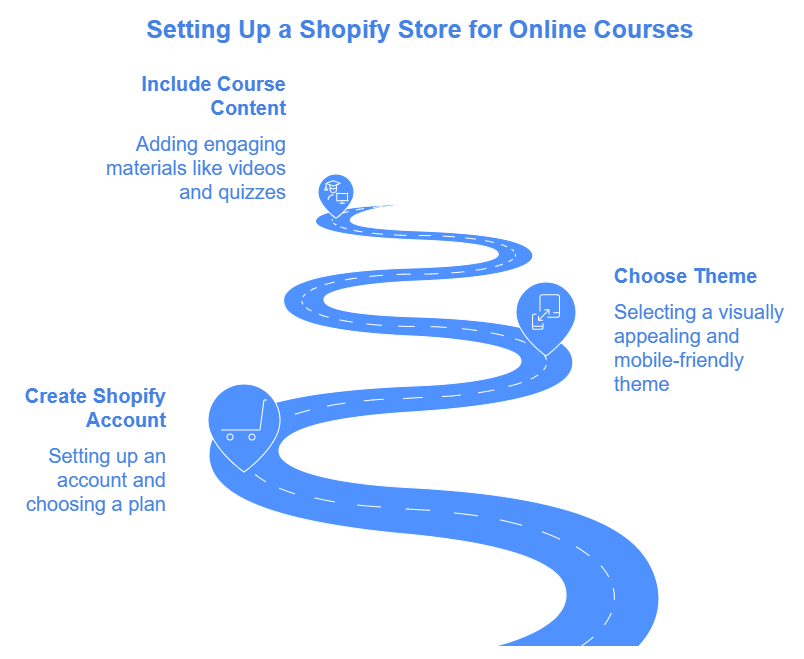From Passion to Profit: Mastering the Art of Selling Online Courses in India via Shopify
Online course selling India
The digital world makes the promise of turning passion to profit more accessible today than ever before. With the boom in online learning, selling online courses has taken on an entirely new level of profitable enterprise. As you have a business in India and want to cash in on this trend, Shopify should be at the top of your list. The following blog will take you through the fundamental steps involved in selling online courses on Shopify, which will help you to monetize your passion business.

Online Course Selling India: Mastering A Shopify Guide to Profitable E-learning
1. Understanding Indian E-learning Course Market (Online course selling India)
1.1 Emergence of E-Learning
E-learning is one of the increasingly fastest-growing industries in India, poised to equip the young population of India with a ready willingness to learn new skills. According to the latest available reports, the market is likely to reach $1.96 billion by 2026. The boom has opened doors to course providers.
1.2 Discover Your Niche
Identify a niche in which your skills and interest lie before you begin. It might be digital marketing, photography, coding, or yoga. Whatever the niche, it is passion that will create quality content for the learner.

2. Why Shopify for Selling Courses? (Online course selling India)
2.1 Ease of Use Interface
Shopify has quickly emerged as one such destination that is easy to use. So, even if you are not one from the techie side of the world, you can have your professional-looking online store up in no time.
2.2 Ready Out-of-the-box Payment Solutions
Shopify makes it easy to handle transactions. It allows multiple payment options, so your Indian audience finds it easier.
2.3 Marketing Tools
Shopify provides you with the most extensive set of marketing tools, from email marketing to SEO optimization, and it will let you promote your courses properly.

3. Setting Up Your Shopify Store (Online course selling India)
3.1 Create Your Account
Set up your Shopify account first. Choose a plan that fits both your budget and needs. Since there is a 14-day free trial, you may test out the application without having to commit to anything.
3.2 Choose Your Theme
Choose a theme appropriate to your subject material. Make sure it looks nice and is mobile friendly, as most will be viewing your website on their phones.
3.3 Inclusion of Course Content
Bring out your course materials now! It’s time to develop engaging learning material for the courses. Videos, PDFs, and quizzes will make the experience rich and satisfying for your learners.

4. Pricing Your Courses (Online course selling India)
4.1 Competitive Analysis
Determine your competitive price by doing competitive research on other similar courses. Offer a few free lessons to attract many students.
4.2 Value Proposition
Communicate a clear value proposition for your courses. You need to let your learners know clearly what they will gain and how that will help them in their personal or professional lives.

5. Marketing Your Online Courses (Online course selling India)
5.1 Making Use of Social Media
Use Instagram, Facebook, and LinkedIn as marketing channels for the courses. Share testimonials, behind-the-scenes images and clips, and excerpts from your lessons.
5.2 Email Marketing
Acquire a contact list of learners who are interested in your courses. Send value-added emails that keep them updated on the features of the course and offer them exclusive offers.
5.3 Collaborations and Partnerships
Influencers or other creators of courses within your niche. A partnership with someone can generate exposure to more audiences and attract new students.

6. Engaging with Your Audience (Online course selling India)
6.1 Creating a Community
Encourage interactivity in the class. Use services such as Discord or Facebook Groups to create a sense of community.
6.2 Feedback and Improvement
Be sure to seek feedback from your students. This can help you advance your courses and ensure you are fulfilling their needs.

7. Scaling Your Course Business (Online course selling India)
7.1 Offering More Courses
After you have created your initial course you can begin to provide other courses or even levels of those courses and this will keep the students coming and escalating revenue.
7.2 Affiliate Marketing
Introduce an affiliate marketing program whereby students are rewarded with a percentage for every person they refer to your courses.

8. Legal Considerations (Online course selling India)
8.1 GST Registration
In India, you’d need to register for Goods and Services Tax if you earn more than the threshold level. Therefore, you must be aware of the local rules so you don’t get penalized.
8.2 Terms and Conditions
Keep handy the terms and conditions of your courses especially refund policies and usage rights.

9. Measuring Success (Online course selling India)
9.1 Metrics Monitoring
Make full use of Shopify’s analytics tools for built-in measurement of sales, traffic sources, and customer behaviour. All this data will be a gold mine for taking proper decisions.
9.2 Setting Goals
Set some short-term goals and long-term goals for your course business. Focus on these goals every now and then with what you have achieved so far.

10. Conclusion – Online course selling India
It is completely possible to transform your passion into a lucrative online course business in India by following the right approach. You could put all this together by using the Shopify platform, which is one of the most popular and powerful website-building tools existing today, with a great understanding of the dynamic e-learning market so as to deliver a rewarding venture that not only fulfils your dreams but impacts the lives of students in pursuit of knowledge.

FAQs – Online course selling India
1. Can I sell more than one course on Shopify?
Absolutely! Shopify is designed with the capability of hosting multiple products, such as a different online course. You can offer as many listings of courses as you want, complete with detailed descriptions, prices, and promotional materials. This will allow you to cater to different types of audiences and fulfil various interests so that you can reach the best revenue potential.
2. Do I need to be a tech guru to use Shopify?
No way! Shopify is very friendly and easy to use even for a person of any technical background. You do not need to know any codes to set up your store. The platform has many themes and templates that you can apply with a simple drag-and-drop interface. Shopify has more extensive tutorials and customer support to back you up all the way through.
3. How can I promote my course?
Promoting a course is no easy task and has to rely on multi-aspect input. Here are some ideas, however:
- Social Media Marketing: Share content pertinent to your course, say, in Facebook, Instagram, and LinkedIn. Add teasers, success stories, and testimonials that will interest learners.
- Email Marketing: Create an email list and send news with course updates, valuable content, and exclusive discount. Make it personalized so that you connect with your audience.
- Content Marketing: Start a blog or YouTube channel talking about the topic of your course. So valuable insights will be given to such an extent that you’ll come out as an authority in the niche, which will direct the traffic to your Shopify store.
Collaborations: You can work with influencers or other instructors in your niche. This will allow you to tap into their audience and hence enjoy more visibility.
Online course selling India
4. What are the options for available payment methods using Shopify?
Shopify allows multiple payment channels based on your customers’ preference. In India, you may accept credit/debit card payments, net banking, and UPI besides other local payment gateways like Shopify Payments, PayPal, and Razorpay and fully safely, thereby attracting more customers because they will not have a problem ordering your online courses from your website.
5. Does GST apply for selling online courses in India?
Just like all other business activity, GST applies to online course sales that generate an annual turnover of Rs.20 lakhs and above. If you have exceeded that, then you would be required to register for GST and charge GST on your course fees. You would, of course, require maintaining proper records of your earnings and expenses, but a tax professional would be able to guide you specifically on your situation.
6. How can the course content be engaging?
Effective engagement of course content tends to attract the students and holds their interest in enrolment. Here are some tips:
- Variety of Formats: Combining many videos, PDFs, quizzes, and live sessions, aims at different learning styles. This variety keeps fresh content very engaging.
- Focus on Value: Ensure that the content you give students contains actionable insights and skills that make a difference in real-life settings. Highlight some benefits and outcomes because that tends to drive perceived value.
- Interactive Elements: As part of ways you can foster community, use discussion forums, polls, and assignments to elicit high levels of student participation and interaction in your course.
Version Control: Ensure that the information and trends you are presenting in your course are up-to-date. The continuous review and fine-tuning of your material will serve as proof of your commitment towards an excellent education.
7. How can I judge the performance of my online courses?
Shopify analytics may contain in-depth details to evaluate the performance of sales, demographics of customers, and source of traffic. Some of the key things to be measured here are:
- Sales Data: Monitor your overall sales, conversion rates, and average order value to see profitability.
- Traffic Sources: Discover from where your visitors are coming (social media, organic search, etc.) so that you can channelize your marketing efforts.
- Customer Behaviour: You can use this knowledge about user habits interacting with your store for informed decision-making about your courses and your strategy of marketing.
Setting clear goals and checking your performance from time to time will help evaluate your success and where you need improvement.
Online course selling India
8. How will I deal with refunds and cancellations for my courses?
Create a refund and cancellation policy at the beginning defining the terms by which refunds can be made. You can follow some of the following steps:
- Time Limitation: Specify a time that the students should submit a refund, say, within 30 days after purchase.
- Conditions: Specify the condition under which they can get a refund of their fee, such as course completion or satisfaction guarantees.
Communication: Ensure that your website is easily accessible for your students to reach you either for support or initiation of a refund request. This will help in the smooth and amicable resolution of problems and also maintains a good term with your learners.
9. What resources are available for new course creators?
As an aspiring course creator, there are countless resources to target. Some valuable options include:
- Online Communities: online forums and social media groups that focus on the creation of online courses. It is a place where one can share experiences, ask questions, and attain knowledge from others.
- Courses and Webinars: Enrol for free or paid courses about the creation, marketing, and selling of an online course. Many platforms provide worthwhile content to hone in one’s skills.
- Blogs and Podcasts: Stay on top of some of the most important voices in the online education space with blogs and podcasts that deliver tips, strategies, and success stories.
These are good resources to help you not only go through your course but also sometimes give you the inspiration when you need it most.
Thanks for reading this article.
Please share your thoughts and suggestions on comments field.







One Comment